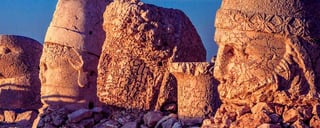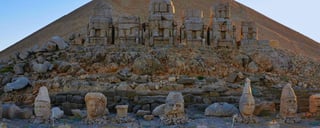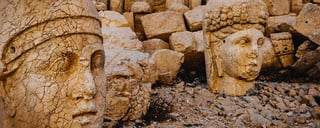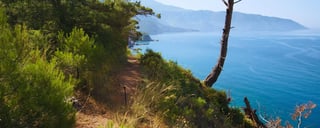Top Things To Do In Mount Nemrut
Mount Nemrut, located in southeastern Turkey, is a UNESCO World Heritage Site known for its ancient statues and stunning sunrise and sunset views.

Here are some things to do in Mount Nemrut:
Visit The Mount Nemrut Summit:
The main attraction of Mount Nemrut is the summit, where you'll find the large statues of ancient gods and kings. Take a walk around the summit to admire the colossal stone heads and enjoy panoramic views of the surrounding landscape.Visiting the Mount Nemrut summit is a must-do activity for anyone traveling to the region.
Here are some key details about the experience:
- Trek to the Summit: To reach the summit of Mount Nemrut, visitors need to hike a well-marked trail that starts from the parking area below. The trail is approximately 800 meters long and involves a moderate level of difficulty. Be prepared for some uphill sections and rocky terrain along the way.
- Witness the Ancient Statues: At the summit, you'll encounter the famous ancient statues of gods, kings, and animals that were built during the reign of King Antiochus I of Commagene in the 1st century BC. The massive stone heads, measuring up to 9 meters in height, are an impressive sight to behold.
- Sunrise or Sunset Viewing: The most popular time to visit the Mount Nemrut summit is during sunrise or sunset. Watching the sun rise or set behind the statues creates a magical ambiance and offers stunning photo opportunities. It is recommended to arrive at the summit before dawn or stay until evening to experience this incredible natural spectacle.
- Explore the Eastern and Western Terraces: Besides the central summit area, there are two terraces on the eastern and western sides of the summit. These terraces feature additional statues and offer different perspectives of the surrounding landscape. Take your time to explore and admire the intricate carvings and unique cultural blend represented in the statues.
- Enjoy the Panoramic Views: From the summit, you'll be rewarded with panoramic views of the surrounding mountains, valleys, and plains. The breathtaking scenery provides a sense of awe and appreciation for the natural beauty of the region.
- Cultural and Historical Significance: Mount Nemrut has significant historical and cultural value, showcasing the fusion of Hellenistic and Persian influences during the Commagene Kingdom. The statues represent the deified ancestors of the kingdom's rulers and their connections to various deities.
- Dress and Preparation: As the summit is at an elevation of about 2,150 meters, it can get chilly, especially during the early morning or evening. Dress in layers and bring warm clothing. Wear comfortable shoes suitable for hiking and bring a flashlight or headlamp if visiting during sunrise or sunset.
- It's important to note that visitors are not allowed to touch or climb on the statues to preserve their integrity. Additionally, respecting the site's cultural significance by following any rules or guidelines provided by authorities is essential.
Witness The Sunrise or Sunset:
Mount Nemrut is famous for its breathtaking sunrise and sunset views. Wake up early to hike up the mountain and witness the sun rising behind the statues or stay until evening to see the golden hues of the sunset cast over the landscape.Witnessing the sunrise or sunset at Mount Nemrut is a breathtaking experience that shouldn't be missed.
Here's what you need to know:
- Sunrise: Many visitors choose to wake up early and make their way to the summit before dawn to witness the sunrise. As the sun gradually appears over the horizon, it casts a golden glow on the statues, creating a magical atmosphere. The changing colors of the sky and the silhouette of the statues make for a truly memorable and serene experience.
- Sunset: If waking up early isn't your preference, you can also visit Mount Nemrut in the late afternoon to witness the sunset. As the sun starts to descend, the statues are bathed in a warm and ethereal light, creating a dramatic and mystical ambiance. The panoramic views of the surrounding landscape coupled with the colorful hues of the sunset make for a captivating sight.
- Timing and Planning: It's important to check the local sunrise and sunset times to ensure you arrive at the summit with enough time to find a good viewing spot. It's advisable to reach the summit at least 30 minutes before the scheduled time to secure a comfortable spot and capture the best views. Consider factors like weather conditions and cloud cover, as they can impact the visibility of the sunrise or sunset.
- Photography Tips: If you're interested in capturing stunning photographs of the sunrise or sunset, bring your camera or smartphone with you. Consider using a tripod to stabilize your shots, especially in low-light conditions. Experiment with different angles and compositions to capture the statues and the surrounding landscape in their best light. Don't forget to enjoy the moment and take some time to simply appreciate the beauty around you.
- Preparation: Since sunrise and sunset times can be quite early or late depending on the season, make sure to dress appropriately for the temperature and weather conditions. Bring warm layers, as it can be chilly at the summit, even in the summer. It's also a good idea to bring snacks, water, and any necessary personal items, as there are no facilities at the summit.
- Witnessing the sunrise or sunset at Mount Nemrut is a unique and awe-inspiring experience that allows you to connect with the natural beauty and historical significance of the site. Be sure to plan accordingly and embrace the peaceful and magical moments as the sun paints the sky with its warm hues.
Explore The Eastern Terrace:

The Eastern Terrace is home to a series of ancient stone statues, including the heads of gods and animals. Take your time to walk along the terrace and appreciate the intricate details of the sculptures.Exploring the Eastern Terrace of Mount Nemrut is an essential part of the experience. Here's what you can expect:
- Ancient Statues: The Eastern Terrace is home to the iconic statues that make Mount Nemrut famous. These colossal statues, dating back to the 1st century BC, represent deities and important figures from the Commagene Kingdom. The statues are seated on thrones and are about 8-9 meters tall. Take your time to marvel at their intricate details and unique features.
- Walking Path: There is a designated walking path that leads visitors around the Eastern Terrace. Follow the path to get a closer look at the statues and explore the archaeological remains in the area. The path offers stunning views of the surrounding landscape, including the Taurus Mountains and the Euphrates River.
- Hieroglyphic Inscriptions: Along the Eastern Terrace, you'll find hieroglyphic inscriptions carved into stone slabs. These inscriptions provide insights into the beliefs and ideologies of the Commagene Kingdom. Take a moment to examine the inscriptions and appreciate the historical significance they hold.
- Sunrise and Sunset Views: The Eastern Terrace offers a prime location to witness the sunrise or sunset at Mount Nemrut. The statues, combined with the panoramic views of the landscape, create a captivating backdrop for these natural phenomena. Consider timing your visit to coincide with these magical moments and capture memorable photos.
- Guided Tours: To enhance your experience and gain deeper insights into the history and significance of the Eastern Terrace, consider joining a guided tour. Knowledgeable guides can provide valuable information about the statues, the Commagene Kingdom, and the archaeological findings in the area.
- Respect and Preservation: As you explore the Eastern Terrace, it's important to be respectful of the site and follow any guidelines or regulations in place. Avoid touching or climbing on the statues to preserve their integrity for future generations. Take only photographs and leave no trace behind.
- The Eastern Terrace of Mount Nemrut offers a fascinating glimpse into the ancient Commagene Kingdom and its rich cultural heritage. Take your time to soak in the atmosphere, appreciate the intricate craftsmanship of the statues, and enjoy the breathtaking views of the surrounding landscape.
Visit The Western Terrace:

The Western Terrace features a similar collection of statues, but with a different arrangement. Marvel at the grandeur of the statues and the stunning views from this vantage point.Exploring the Western Terrace of Mount Nemrut is an important part of the overall experience. Here's what you can expect when visiting the Western Terrace:
- Colossal Statues: Similar to the Eastern Terrace, the Western Terrace is home to impressive statues that represent deities and important figures from the Commagene Kingdom. These statues, standing at around 8-9 meters tall, are seated on thrones and showcase remarkable craftsmanship. Take your time to observe the details and symbolism portrayed in these ancient works of art.
- Hieroglyphic Inscriptions: Just like the Eastern Terrace, the Western Terrace features hieroglyphic inscriptions that provide insights into the history and beliefs of the Commagene Kingdom. These inscriptions are carved into stone slabs and offer a glimpse into the ideology and religious practices of the time. Take a closer look at the inscriptions and appreciate the significance they hold.
- Walking Path: A designated walking path guides visitors around the Western Terrace, allowing you to explore the site at your own pace. As you follow the path, you'll have the opportunity to view the statues up close, examine the inscriptions, and enjoy panoramic views of the surrounding landscape.
- Sunset and Sunrise Views: The Western Terrace of Mount Nemrut is renowned for its stunning sunset and sunrise views. The combination of the colossal statues, the dramatic landscape, and the changing colors of the sky creates a truly mesmerizing experience. Consider timing your visit to witness these magical moments and capture unforgettable photographs.
- Guided Tours: Joining a guided tour can enhance your visit to the Western Terrace by providing informative commentary and historical context. Knowledgeable guides can share insights into the significance of the statues, the Commagene Kingdom, and the archaeological discoveries in the area.
- Respect and Preservation: It's important to show respect for the site and follow any guidelines or regulations in place. As with the Eastern Terrace, avoid touching or climbing on the statues to preserve their integrity. Leave the site as you found it, taking only memories and photographs.
- Visiting the Western Terrace of Mount Nemrut offers a unique opportunity to connect with ancient history and immerse yourself in the fascinating world of the Commagene Kingdom. Take your time to absorb the atmosphere, appreciate the grandeur of the statues, and witness the natural beauty that surrounds this remarkable archaeological site.
Hike The Surrounding Trails:

Mount Nemrut offers various hiking trails that allow you to explore the natural beauty of the area. Take a hike through the picturesque landscape, enjoying the fresh mountain air and the tranquility of the surroundings.Hiking the surrounding trails near Mount Nemrut is a popular activity for nature enthusiasts and adventure seekers.
Here are some key points about hiking in the area:
- Nature Trails: The region surrounding Mount Nemrut is blessed with natural beauty, including lush forests, rugged terrains, and picturesque landscapes. There are several marked hiking trails that allow you to explore the area and take in the stunning views. These trails vary in difficulty and length, catering to both casual hikers and more experienced trekkers.
- Nemrut National Park: Mount Nemrut is located within Nemrut National Park, which offers a network of hiking trails. These trails often wind through diverse ecosystems, such as pine forests and alpine meadows. As you hike, you may encounter unique flora and fauna, including wildflowers, birds, and even the occasional wildlife.
- Sunrise and Sunset Hikes: One of the highlights of hiking in the Mount Nemrut area is the opportunity to witness spectacular sunrises or sunsets. Many hikers choose to embark on early morning or late afternoon hikes to reach vantage points that provide breathtaking views of the surrounding landscape as the sun casts its warm glow.
- Historical Sites: While hiking the trails, you may come across ancient ruins, remnants of the region's rich historical past. These sites add an extra layer of fascination to your hiking experience, allowing you to connect with the history and cultural heritage of the area.
- Guided Hiking Tours: If you prefer a more structured hiking experience, guided tours are available that provide knowledgeable guides to lead you along the trails. These guides offer insights into the natural and cultural aspects of the region, enhancing your hiking experience.
- Safety Precautions: When hiking in the Mount Nemrut area, it is essential to be prepared and take necessary safety precautions. Wear appropriate hiking shoes, carry water and snacks, and dress in layers to accommodate changing weather conditions. It's also advisable to hike with a companion or in a group, especially if you're less experienced or unfamiliar with the area.
- Hiking the surrounding trails near Mount Nemrut allows you to immerse yourself in nature, enjoy panoramic views, and discover the historical wonders of the region. Whether you choose a short nature walk or a more challenging trek, the hiking opportunities in this area are sure to leave you with lasting memories of your visit to Mount Nemrut.
Visit The Karakus Tumulus:

Located near the summit of Mount Nemrut, the Karakus Tumulus is an ancient burial mound. Explore the area and learn about the historical significance of this archaeological site.The Karakus Tumulus, also known as the Karakuş Hill, is an archaeological site located near Mount Nemrut in southeastern Turkey.
Here's some information about visiting the Karakus Tumulus:
- Historical Significance: The Karakus Tumulus is an ancient burial mound that dates back to the Hellenistic period, around the 1st century BC. It is believed to be the burial site of a royal or noble figure, although the exact identity remains unknown. The tumulus is known for its impressive size and the rich architectural elements that adorn it.
- Architectural Features: The Karakus Tumulus is distinguished by its monumental entrance, which features a carved relief of an eagle or vulture, giving it the name "Karakus" (meaning "black bird" in Turkish). The relief is believed to represent a deity associated with death and the afterlife. The tumulus itself is made of stone and earth, with a diameter of approximately 100 meters.
- Excavations and Preservation: The Karakus Tumulus has undergone archaeological excavations to uncover its secrets and preserve its historical significance. Excavations have revealed burial chambers, funerary objects, and architectural elements, shedding light on the burial practices and beliefs of the ancient inhabitants of the region.
- Visiting the Site: To visit the Karakus Tumulus, you can join a guided tour or arrange for transportation to the site. It is advisable to hire a local guide who can provide you with historical and cultural insights. Keep in mind that the site is located in a remote area, so it's recommended to plan your visit accordingly and be prepared for the journey.
- Cultural and Natural Surroundings: The Karakus Tumulus is situated in a picturesque landscape, surrounded by the beauty of Mount Nemrut and the Euphrates River valley. The site offers panoramic views of the surrounding mountains and the lush vegetation that characterizes the region. It provides a unique opportunity to connect with the natural beauty and cultural heritage of the area.
- Respectful Visit: When visiting the Karakus Tumulus, it is important to show respect for the archaeological site and its historical significance. Follow any rules and regulations set by the authorities, avoid damaging or removing any artifacts, and leave the site as you found it to preserve its integrity for future generations.
- A visit to the Karakus Tumulus offers a glimpse into the ancient past and allows you to appreciate the architectural and cultural heritage of the region. It is a fascinating site to explore, providing a deeper understanding of the historical and archaeological significance of the area surrounding Mount Nemrut.
Learn The History:
Mount Nemrut has a rich history dating back to the 1st century BC. Take the time to learn about the cultural and historical significance of the statues and the surrounding area, either through on-site information or by hiring a guide.Learning the history of Mount Nemrut and its surrounding area is an enriching experience that allows visitors to appreciate the significance of this UNESCO World Heritage Site.
Here are some key points to understand the history of Mount Nemrut:
- Commemorative Monument: Mount Nemrut is home to a monumental tomb-sanctuary built by King Antiochus I of Commagene in the 1st century BC. The purpose of the sanctuary was to honor Antiochus himself, as well as his ancestors and the deities associated with his kingdom.
- Cultural Syncretism: The sanctuary at Mount Nemrut reflects the unique cultural syncretism of the time. It combines elements from Greek, Persian, and local Anatolian cultures, showcasing the diverse influences that shaped the region during the Hellenistic period.
- Statues and Hierarchies: The most prominent feature of Mount Nemrut is its colossal statues, which depict a combination of deities and royal figures. The statues are seated on thrones and arranged in a symmetrical manner, reflecting the hierarchical structure of the Commagene kingdom.
- Divine Connections: The statues on Mount Nemrut represent a combination of Greek and Persian deities, as well as the deified ancestors of King Antiochus. The blending of different religious and cultural beliefs is a testament to the cosmopolitan nature of the region during that time.
- Abandonment and Rediscovery: The sanctuary on Mount Nemrut was abandoned in the centuries following Antiochus' death, and the site remained hidden until its rediscovery in the 19th century. Excavations and restoration efforts have allowed us to understand the grandeur and symbolism of the site.
- UNESCO World Heritage Site: In recognition of its cultural and historical significance, Mount Nemrut was designated as a UNESCO World Heritage Site in 1987. It serves as a testimony to the artistic and religious achievements of the Hellenistic period and attracts visitors from around the world.
- Visitors to Mount Nemrut can delve deeper into its history by exploring the ancient inscriptions, intricate reliefs, and remaining architectural elements. Local guides and informational signs provide further insights into the cultural, religious, and political context of the sanctuary. By learning the history of Mount Nemrut, visitors can truly appreciate the site's significance and the legacy it represents.
Capture Stunning Photos:
Mount Nemrut provides countless photo opportunities with its dramatic scenery and ancient statues. Capture the beauty of the statues, the landscape, and the sunrise or sunset to preserve your memories of this unique destination.Mount Nemrut offers breathtaking and picturesque views, making it a paradise for photography enthusiasts.
Here are some tips to capture stunning photos:
- Sunrise and Sunset: The best time to photograph Mount Nemrut is during sunrise or sunset when the light creates a dramatic atmosphere. The golden hour provides soft, warm light that beautifully illuminates the statues and surrounding landscape.
- Composition: Consider the composition of your photos to highlight the grandeur of the statues and the natural beauty of the surroundings. Experiment with different angles, perspectives, and focal lengths to create interesting and visually appealing compositions.
- Silhouettes: Capture the statues as striking silhouettes against the colorful sky during sunrise or sunset. This technique can create a powerful and mysterious atmosphere in your photos.
- Rule of Thirds: Use the rule of thirds to create a balanced composition. Place the statues or other elements of interest along the intersecting lines or at the points of intersection to create visual harmony.
- Details and Close-ups: Don't forget to capture the intricate details and expressions on the statues. Zoom in or use a macro lens to focus on smaller elements, capturing the fine craftsmanship and unique features.
- Wide-angle Views: Mount Nemrut offers panoramic vistas that are perfect for wide-angle shots. Capture the grandeur of the entire site, including the statues, surrounding mountains, and the vast sky.
- Long Exposure: Experiment with long exposure photography to capture the movement of clouds or stars. This technique can create a dreamy and ethereal effect in your photos.
- Incorporate People: Including people in your photos can add a sense of scale and provide a human element to the scene. It can also showcase the interaction between visitors and the awe-inspiring environment.
- Remember to respect the site and follow any guidelines or restrictions for photography. Mount Nemrut is not only a visual wonder but also a place of historical and cultural significance, so capturing its beauty responsibly will help preserve its legacy for future generations.
- Remember to check the local regulations and opening hours of Mount Nemrut, as they may vary. Dress appropriately for the weather and terrain, and bring water, sunscreen, and comfortable shoes for your visit.
